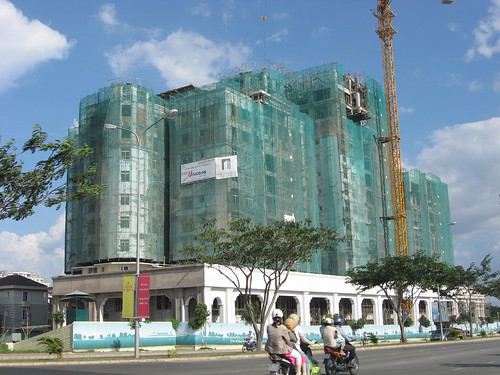Sinking soil was threatening the stability of high-storey buildings in some areas in Ha Noi, which could lead to their collapse, warned relevant offices.
A survey of Ha Noi's weak foundations, conducted by the Federation of Hydrography and Construction Geology, found that Linh Dam and Thanh Cong areas were unsafe for high-storey buildings or full exploitation of underground water sources.

In mid-October, the owner of a flat at Linh Dam new urban area, Ha Noi, was seriously injured because the ceiling collapsed.
Do Minh Toan, ex-chairman of the Ha Noi University of Mining and Geology's Geological Faculty, warned of Ha Noi's inner area's weak foundations.
Nam Thang Long new urban area was at risk of sinking, he said.
Areas where the soil runs a high risk of sinking include Ngoc Khanh, Giang Vo's B6 residential quarter, Thanh Cong, Thanh Nhan Hospital's surroundings, Gia Lam District's Viet Hung high-storey buildings, Me Tri, My Dinh and Linh Dam.
Toan made the warnings based on geological surveys by the Institute of Technological Science and Construction, and the Ha Noi University of Mining and Geology.
According to a recent report, water levels in the northern region had dropped in the first six months of the year.
Underground water levels were 35m lower than the deepest recorded level in Ha Dinh centre in Ha Noi, the report said. The figure was 0.8m lower than the same period last year.
Toan warned that a drop in underground water levels could trigger the soil to sink and cause collapses at construction sites. Worse still, sinking soil would affect technical planning and increase the city's flood risk, he said.
Shaky ground
Toan said it was possible to construct high-storey buildings in risky areas in Ha Noi, however proper surveys had to be conducted prior to construction.
"Design must based on geological examinations," he said.
He advised construction site investors to employ experienced architects who were equipped with extensive knowledge on soil foundation, technical planning and geology.
"Of course, the cost of building in areas at risk of sinking will be higher compared to other areas," Toan said.
A map to mark off the at-risk zones in Ha Noi was drawn up by Ha Noi University of Mining and Geology architects, and has identified clearly which areas are at risk of sinking.
Geologist Le Tu Hai said that with the soil full of empty pockets, there was a high risk of buildings collapsing.
"A likely consequence is cracks in the walls of buildings," Hai said. Nguyen Van Dan from the Federation of Hydrography and Construction Geology also confirmed that Ha Noi's soil was certainly at risk of sinking.
A survey of Ha Noi's weak foundations, conducted by the Federation of Hydrography and Construction Geology, found that Linh Dam and Thanh Cong areas were unsafe for high-storey buildings or full exploitation of underground water sources.

In mid-October, the owner of a flat at Linh Dam new urban area, Ha Noi, was seriously injured because the ceiling collapsed.
Do Minh Toan, ex-chairman of the Ha Noi University of Mining and Geology's Geological Faculty, warned of Ha Noi's inner area's weak foundations.
Nam Thang Long new urban area was at risk of sinking, he said.
Areas where the soil runs a high risk of sinking include Ngoc Khanh, Giang Vo's B6 residential quarter, Thanh Cong, Thanh Nhan Hospital's surroundings, Gia Lam District's Viet Hung high-storey buildings, Me Tri, My Dinh and Linh Dam.
Toan made the warnings based on geological surveys by the Institute of Technological Science and Construction, and the Ha Noi University of Mining and Geology.
According to a recent report, water levels in the northern region had dropped in the first six months of the year.
Underground water levels were 35m lower than the deepest recorded level in Ha Dinh centre in Ha Noi, the report said. The figure was 0.8m lower than the same period last year.
Toan warned that a drop in underground water levels could trigger the soil to sink and cause collapses at construction sites. Worse still, sinking soil would affect technical planning and increase the city's flood risk, he said.
Shaky ground
Toan said it was possible to construct high-storey buildings in risky areas in Ha Noi, however proper surveys had to be conducted prior to construction.
"Design must based on geological examinations," he said.
He advised construction site investors to employ experienced architects who were equipped with extensive knowledge on soil foundation, technical planning and geology.
"Of course, the cost of building in areas at risk of sinking will be higher compared to other areas," Toan said.
A map to mark off the at-risk zones in Ha Noi was drawn up by Ha Noi University of Mining and Geology architects, and has identified clearly which areas are at risk of sinking.
Geologist Le Tu Hai said that with the soil full of empty pockets, there was a high risk of buildings collapsing.
"A likely consequence is cracks in the walls of buildings," Hai said. Nguyen Van Dan from the Federation of Hydrography and Construction Geology also confirmed that Ha Noi's soil was certainly at risk of sinking.
Source: Vietnam News

Post a Comment
Post a Comment